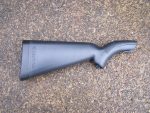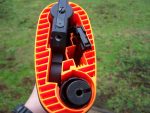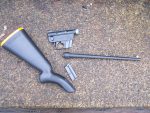

| Online: | |
| Visits: | |
| Stories: |

| Story Views | |
| Now: | |
| Last Hour: | |
| Last 24 Hours: | |
| Total: | |
Pat Cascio’s Product Review: Henry Rifles U.S. Survival AR-7 Rifle
When asked by my wife or daughters what I want for my birthday or Christmas, I have a pretty set answer– “something that goes bang or cuts.” So, I’m fairly easy to shop for these days. Last Christmas my beautiful wife bought me a Henry U.S. Survival AR-7 Survival Rifle, and it is a most welcomed addition to my meager firearms battery. While just about any firearm can be used for “survival” purposes, the AR-7 was designed specifically to be a compact rifle that was designed to aid in actual survival situations.
Some history on the AR-7 is in order, of course. The AR-7 was designed by Eugene Stoner, who designed the AR-15/M-16 military rifle that is still in use today, albeit under a different nomenclature. Stoner designed the AR-7 way back in 1958, and it was first mass produced in 1959. The AR-7 was designed with Air Force pilots in mind, first and foremost; in the event they were shot down they would have a weapon for self defense or for hunting food. Now, you simply don’t see the AR-7 in the hands of pilots who were shot down. Instead, they are always seen with a handgun of some kind in a shoulder holster. Given my druthers, in a real survival situation, I much prefer a long gun over a handgun any day of the week.
The AR-7 is chambered in .22 LR and has been manufactured over the years by a number of different gun makers, starting with Armalite. Other makers included Charter Arms, Herter’s Outdoor Supply, and some were made in Argentina as well as in Israel. I’ve owned an original Armalite and the Charter Arms versions over the years, and neither worked reliably enough for me to want to bet my life on them. The AR-7 is a semi-automatic blow-back action rifle that holds an 8-rd magazine. Although after-market mags are available that hold more rounds, I haven’t found one that was reliable.
The unique feature of the AR-7 Survival Rifle is the fact that it is a take-down rifle; the receiver and barrel can be separated from the stock and stored in the plastic stock that is advertised as being “water resistant”. It makes for a very neat package that is easy to carry in a backpack or in a pilot’s survival pack. The entire gun only weighs about 3.5 lbs, and when assembled it is 35 inches long. Stowed in the stock, it is only 16.5 inches long, which is very compact for a rifle.
The front sight on the Henry version is bright orange and made out of plastic, and the rear sight is a peep sight. The Henry version has the receiver and barrel Teflon coated to help prevent it from rusting. There is also a milled rail on the receiver, should one wish to top the AR-7 with some kind of scope. However, the scope would have to be removed before storing the receiver in the stock. Two magazines come with the gun.
Source: https://survivalblog.com/pat-cascios-product-review-henry-rifles-u-s-survival-ar-7-rifle/





